
Nicaragua, officially the Republic of Nicaragua, is the largest country in Central America, bordered by Honduras to the north, the Caribbean to the east, Costa Rica to the south, and the Pacific Ocean to the west. Managua is the country's capital and largest city. As of 2015, it was estimated to be the third largest city in Central America. Nicaragua's multiethnic population of six million includes people of mestizo, Indigenous, European and African heritage. The main language is Spanish. Indigenous tribes on the Mosquito Coast speak their own languages and English.

A tamale, in Spanish tamal, is a traditional Mesoamerican dish made of masa, a dough made from nixtamalized corn, which is steamed in a corn husk or banana leaves. The wrapping can either be discarded prior to eating or used as a plate. Tamales can be filled with meats, cheeses, fruits, vegetables, herbs, chilies, or any preparation according to taste, and both the filling and the cooking liquid may be seasoned.

Mulled wine, also known as spiced wine, is an alcoholic drink usually made with red wine, along with various mulling spices and sometimes raisins, served hot or warm. It is a traditional drink during winter, especially around Christmas. It is usually served at Christmas markets in Europe, primarily in Germany, Austria, Switzerland and eastern France. There are non-alcoholic versions of it. Vodka-spiked mulled wine can be found in Polish Christmas markets, where mulled wine is commonly used as a mixer.

Costa Rican cuisine is known for being mostly mild, with high reliance on fruits and vegetables. Rice and black beans are a staple of most traditional Costa Rican meals, often served three times a day. Costa Rican fare is nutritionally well rounded, and nearly always cooked from scratch from fresh ingredients. Owing to the location of the country, tropical fruits and vegetables are readily available and included in the local cuisine.
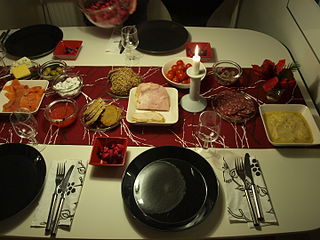
Joulupöytä is the traditional assortment of foods served at Christmas in Finland. It contains many different dishes, most of them typical for the season.

Beavis is a fictional character who serves as one of two protagonists from the MTV/Paramount+ animated series Beavis and Butt-Head. He is voiced by the show's creator, Mike Judge. In the movie Beavis and Butt-Head Do the Universe, Beavis' mother is referred to as "Shirley Beavis", implying that Beavis is actually the character's last name. His father is a former Mötley Crüe roadie.

Rice pudding is a dish made from rice mixed with water or milk and other ingredients such as cinnamon, vanilla and raisins.

Culture of Nicaragua has many influences. The western part was colonized by the Spanish and its culture is similar to that of other Hispanic countries. The inhabitants of western Nicaragua are mostly triracial(Indigenous, West African, European) and the main language is invariably Spanish.
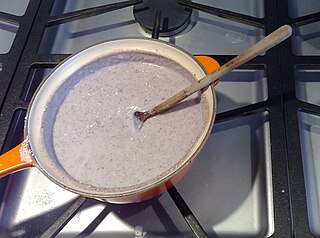
Atole, also known as atolli and atol de elote. However, it is also believed to come from Mayan origin. It is a traditional hot corn- and masa-based beverage of Mexican origin. Atole can have different flavors added such as vanilla, cinnamon, and guava. Chocolate atole is known as champurrado or atole. It typically accompanies tamales and is very popular during Day of the Dead and Las Posadas.

Chicharrón is a dish generally consisting of fried pork belly or fried pork rinds. Chicharrón may also be made from chicken, mutton or beef.
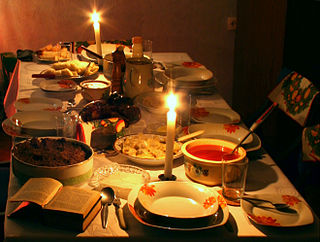
A twelve-dish Christmas Eve supper is traditionally prepared to commemorate Jesus' twelve disciples in Central, Northern and Eastern European cultures, especially those that were formerly part of the Polish–Lithuanian Commonwealth and neighbouring countries. The tradition is especially cultivated in modern-day Poland, where alternatively thirteen meatless dishes on Christmas Eve are sometimes served.
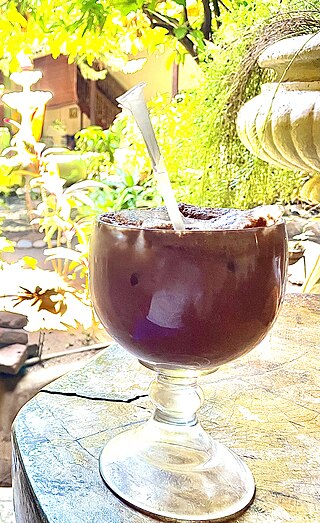
Pinolillo is a sweet cornmeal and cacao-based traditional drink in Nicaragua, also consumed in Costa Rica. It is made of ground toasted corn and a small amount of cacao. It can be mixed with water or soy milk, and served sweetened or unsweetened. If unsweetened, it is rather bitter. The drink usually has a rough, gritty texture.
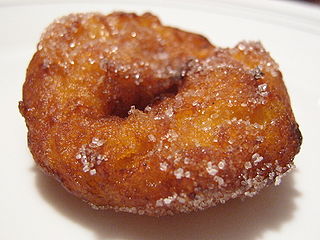
A buñuelo is a fried dough fritter found in Spain, Latin America, and other regions with a historical connection to Spaniards, including Southwest Europe, the Balkans, Anatolia, and other parts of Asia and North Africa. Buñuelos are traditionally prepared at Christmas. It will usually have a filling or a topping. In Mexican cuisine, it is often served with a syrup made with piloncillo.

Jul or jol is the term used for the Christmas holiday season in Scandinavia and parts of Scotland. Originally, jul was the name of a month in the old Germanic calendar. The concept of jul as a period of time rather than a specific event prevailed in Scandinavia; in modern times, jul is a period of time stretching from the fourth Sunday before Christmas Eve, December 24, to (traditionally) mid-January at the date of Epiphany with the month of December and Christmas, and the week up to the New Year, as its highlight. The modern English yule and yuletide are cognates with this term.
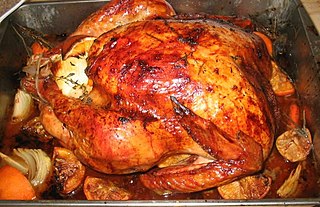
Christmas dinner is a meal traditionally eaten at Christmas. This meal can take place any time from the evening of Christmas Eve to the evening of Christmas Day itself. The meals are often particularly rich and substantial, in the tradition of the Christian feast day celebration, and form a significant part of gatherings held to celebrate the arrival of Christmastide. In many cases, there is a ritual element to the meal related to the religious celebration, such as the saying of grace.
Belizean Creoles, also known as Kriols, are a Creole ethnic group native to Belize.

The banana leaf is the leaf of the banana plant, which may produce up to 40 leaves in a growing cycle. The leaves have a wide range of applications because they are large, flexible, waterproof and decorative. They are used for cooking, wrapping, and food-serving in a wide range of cuisines in tropical and subtropical areas. They are used for decorative and symbolic purposes in numerous Hindu and Buddhist ceremonies. In traditional homebuilding in tropical areas, roofs and fences are made with dry banana-leaf thatch. Bananas and palm leaves were historically the primary writing surfaces in many nations of South and Southeast Asia.
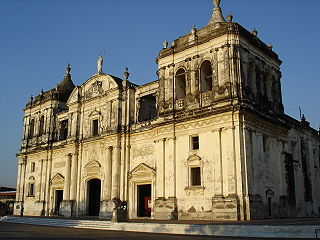
Religion in Nicaragua is predominantly Christian and forms a significant part of the culture of the country as well as its constitution. Religious freedom and religious tolerance is promoted by the Nicaraguan constitution yet the government has in recent years detained, imprisoned, and likely tortured numerous Catholic leaders, according to multiple news outlets.
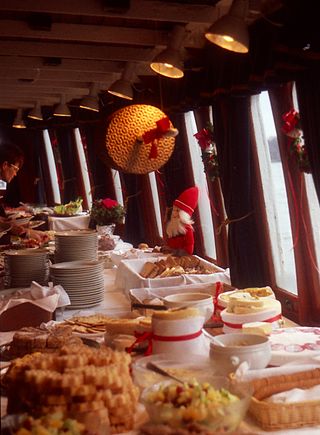
Julebord is a Scandinavian feast or banquet during the Christmas season where traditional Christmas food and alcoholic beverages are served. Originally, the julebord belonged to Christmas itself, i.e. the period from Christmas Day and onwards. Today julebord is often organized by employers or organizations for the employees or members.

















